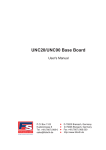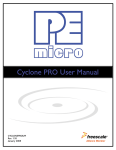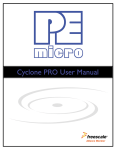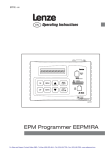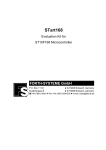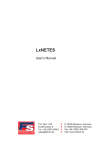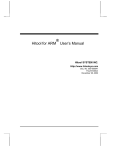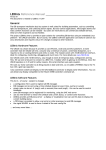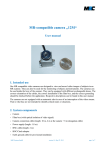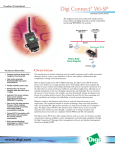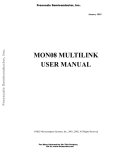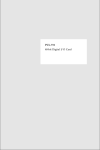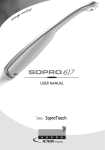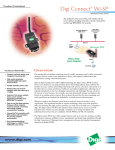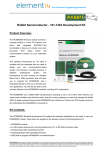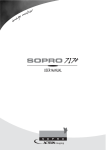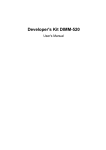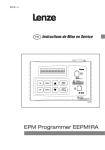Download Documentation: UNC20 Base Board Users Manual
Transcript
UNC20 Base Board User's Manual P.O: Box 1103 Kueferstrasse 8 Tel. +49 (7667) 908-0 [email protected] • • • • D-79200 Breisach, Germany D-79206 Breisach, Germany Fax +49 (7667) 908-200 http://www.fsforth.de UNC20 Base Board User's Manual Copyright 2003: FS Forth-Systeme GmbH Postfach 1103, 79200 Breisach, Germany Release of Document: Filename: Author: Board Revision: September 29, 2003 UNC20_BASE2_UM.doc N. James UNCBAS_2 All rights reserved. No part of this document may be copied or reproduced in any form or by any means without the prior written consent of FS Forth-Systeme GmbH. 2 UNC20 Base Board User's Manual Table of Contents 1. General ..........................................................................................................4 2. Features .........................................................................................................4 3. Block Diagram Of Base Board ........................................................................5 4. Detailed Description .......................................................................................6 4.1. UNC20 Module .....................................................................................6 4.2. RS232 Serial Interface..........................................................................7 4.2.1. Serial Port 1..............................................................................7 4.2.2. Serial Port 2..............................................................................8 4.3. Ethernet................................................................................................8 4.4. JTAG / Debugging ................................................................................9 4.4.3. Parallel Port JTAG Adapter.....................................................10 4.4.4. JTAG Booster .........................................................................10 4.4.5. ARM-standard JTAG Connector .............................................11 4.5. Peripherals .........................................................................................12 4.5.6. Switches and LEDs.................................................................13 4.5.7. Character Display ...................................................................13 4.5.8. Wire-Wrap Area ......................................................................14 4.6. USB....................................................................................................15 4.7. Power Supply and Reset ....................................................................16 4.7.9. Voltage Requirements ............................................................16 5. UNC20 Connector ........................................................................................17 3 UNC20 Base Board User's Manual 1. General The UNC20 Base Board is the standard carrier board as used in the UNC20 Developer’s Kits. This document refers to the UNCBAS_2 revision of the board, which has the Part Number 358. The board’s name can be found on the label above the combined part number / serial number. 2. Features • Base board which accommodates one UNC20 Module • Ethernet interface with RJ45 connector with integrated link LED • 1 serial communication RS232 interfaces • JTAG interface • LEDs for power and communication • 2 switches for use by application • Reset switch • Support for external Character Display • Provision for future host USB support (USB1.1 compliant) 4 UNC20 Base Board User's Manual 3. Block Diagram Of Base Board JTAG 20-pin Display Power Pot JTAG Booster JTAG Wire-wrap field DB25P UNC20 Serial DB9P J1 Reset RJ-45 5 UNC20 Base Board User's Manual 4. Detailed Description 4.1. UNC20 Module The UNC20 Module is a cost-effective, highly integrated module in a 48-pin dualinline package. The salient features of the UNC20 Module, as delivered with the Developer’s Kit, are listed below: • NetSilicon’s NS7520 microcontroller based on a 32-bit ARM7TDMI core • 16 Mbytes SDRAM • 8 Mbytes Flash • Ethernet interface • 2 serial communication interfaces • I2C interface • JTAG interface Please refer to the UNC20 User’s Manual for more details on this module. The pin-out for the UNC20 Module can be found at the end of this Manual. 6 UNC20 Base Board User's Manual 4.2. RS232 Serial Interface The NS7520 provides two serial ports. Since these ports are multiplexed with the General Purpose I/O pins (ports A and C), it was decided only to assemble one serial port and leave the other for the user to configure. 4.2.1. Serial Port 1 Serial Port 1 can be used as a console port to communicate with a host PC. An RS232 driver, the MAX3320 from Maxim, is assembled on the Base Board. This driver guarantees baudrates up to 250kbps. This port will operate in asynchronous RS232 full-duplex mode. The RS232 port supports minimal hardware control signals, namely RTS and CTS only, and is derived from the UNC20 module’s Port C pins. A 9-pin D-type connector (male) is assembled on the base board. The pin allocation of the 9 way D-type connector is as defined in the table below: Pin Function 1 N/C 2 RXD 3 TXD 4 N/C 5 GND 6 N/C 7 RTS 8 CTS 9 N/C 7 UNC20 Base Board User's Manual If a serial console is not required and the 4 PortC pins are required for GPIO, then the serial driver can be forced into an “off” state, meaning that the on-chip pwer supply is shut down, by connecting a jumper between pins 3 & 4 of J1. PIN A Description when inserted 3 Serial driver forced off 4 Jumper settings for J1 Factory default Not inserted = connected pins To disable the serial driver, the jumper has to be inserted. 4.2.2. Serial Port 2 Serial Port 2 is available on the UNC20 module’s Port A [0-7] pins, which are led out to the wire-wrap area, so that users can configure this port to suit their application. 4.3. Ethernet The 10/100 Ethernet MAC controller and PHY are included on the UNC20 Module. An RJ45 jack is used with a status LED for Link/Activity which is visible through a light pipe in the jack. A separate Pulse transformer is assembled. The pin allocation of the RJ45 connector is as defined in the table below: 8 Pin Function 1 TD+ 2 TD- UNC20 Base Board User's Manual 3 RD+ 4 N/C 5 N/C 6 RD- 7 N/C 8 N/C 4.4. JTAG / Debugging A JTAG interface is required both for debug purposes and for boundary scan testing of the UNC20 Module during the manufacturing process. The address lines ADDR[5..9] from the processor are multiplexed with the 5 JTAG lines. The selection is done via the LEDLNK/SEL signal. JTAG is active when the LED, connected to LEDLNK/SEL, is shorted to ground. This is achieved by inserting a jumper (J1) on the base board. PIN A Description when inserted 1 JTAG active 2 Jumper settings for J1 Factory default Not inserted = connected pins To activate the JTAG interface, the jumper has to be inserted. There are 3 connectors available on the base board for accessing JTAG: firstly, the ARM-defined 20-pin header; secondly, the 8-pin header for FS ForthSysteme’s JTAG Booster; thirdly, the Parallel Port JTAG adapter (PPJ) is implemented on the board using a buffer together with a standard 25-pin parallel port connector (DB25P). 9 UNC20 Base Board User's Manual 4.4.3. Parallel Port JTAG Adapter The parallel port JTAG adapter allows for a direct connection between the host PCs parallel port and the JTAG pins of the UNC20. This allows a number of lowcost Development Tools to be used without additional hardware. A 25-pin male D-type connector (X5) is provided for this purpose. Pin Parallel Function JTAG Function 2 D0 TDI 3 D1 TMS 4 D2 TCK 5 D3 TRST# 7 D5 Reset# 8 D6 Port Sense 10 ACK# Port Sense 12 PE TDO 15 ERROR# VCC sense A parallel cable for connecting the host PC’s parallel port to X5 is provided with the UNC20 Developer’s Kits. 4.4.4. JTAG Booster FS Forth-Systeme offers a JTAG Booster which allows accelerated programming of the on-board Flash. An 8-pin header (X3) is provided for connecting the JTAG Booster. Note that the JTAG Booster is not part of the standard UNC20 Developer’s Kit. 10 UNC20 Base Board User's Manual 4.4.5. ARM-standard JTAG Connector The JTAG connector is a 20-pin header as defined by ARM Ltd. and can be used for connecting a range of development tools such as ARM’s Multi-ICE, Abatron’s BDI2000 and EPI’s JEENI. Pin Function Pin Function 1 3.3V 2 3.3V 3 TRST# 4 GND 5 TDI 6 GND 7 TMS 8 GND 9 TCK 10 GND 11 RTCK 12 GND 13 TDO 14 GND 15 SRST# 16 GND 17 N/C 18 GND 19 N/C 20 GND The signal RTCK is not used and is connected via a 0R resistor to TCK. 11 UNC20 Base Board User's Manual 4.5. Peripherals An 8-bit data bus and 10-bit address bus are provided for connecting external peripherals to the UNC20. Two individually programmable chip selects (CS3# and CS4#) and an OE# (Output Enable) and WE# (Write Enable) signal allow a vast range of 8-bit peripherals to be connected directly to the UNC20 without any glue logic. In addition, the UNC20 Module has two 8-bit General Purpose I/O ports (GPIO). Some of these 16 GPIO pins are already used on the Base Board. The following table gives an overview, showing those signals which are free to be used by additional hardware in the wire-wrap area. Port A 12 Use Port C Use A0 Free C0 Push-button (free don’t use button) if A1 Free C1 Serial_1_CTS A2 Free C2 I2C (SDA) A3 Free C3 Serial_1_RxD A4 LED (free if jumper removed) C4 Push-button (free don’t use button) A5 Free C5 Serial_1_RTS (free if don’t use Serial_1) A6 LED (free if jumper removed) C6 I2C (SCL) A7 Free C7 Serial_1_TxD (free don’t use Serial_1) if if UNC20 Base Board User's Manual 4.5.6. Switches and LEDs The Base Board contains 2 push-buttons which can be used by the application to input information. Also 2 user LEDs are assembled to signal output activity for the applications. The 2 LEDs and 2 switches are connected to 4 GPIO pins. Since the LEDs use Port A4 and Port A6, which might be required by other peripherals in the wire-wrap area, they can be disabled by removing J1/5-6. PIN A Description when inserted 5 LEDs active 6 Jumper settings for J1 Factory default Inserted = connected pins 4.5.7. Character Display A 16-pin header (X8), with 0.1” (2.54mm) spacing, is available on the Base Board to allow the user to add a simple character display module, e.g. 20 characters by 4 lines or 20 characters by 2 lines. A potentiometer is also assembled for adjusting the contrast (VO). The display uses CS3#. This display module is not included with the UNC20 Developer’s Kit. Since the pinning is standardized, these modules are readily available. Pin Symbol Description 1 VSS GND 2 VDD +5V 3 VO LCD contrast adjust 4 RS Register Selection 5 R/W# Read / Write# 6 E Enable 7 D0 8 D1 9 D2 13 UNC20 Base Board User's Manual 10 D3 11 D4 12 D5 13 D6 14 D7 15 VLED + LED Backlight Anode 16 VLED - LED Backlight Cathode 4.5.8. Wire-Wrap Area A wire-wrap area is provided on the Base Board to allow users to quickly try out their own peripherals. On the left of the wire-wrap area is the 42-pin header X6, which is not assembled. Pinout of X6 is described below. 14 Pin Function Pin Function 1 ADDR4 2 3.3V 3 ADDR5 4 CS4# 5 ADDR6 6 CS3# 7 ADDR7 8 OE# 9 ADDR8 10 WE# 11 ADDR9 12 ADDR3 13 PortA0 14 ADDR2 15 PortA1 16 ADDR1 17 PortA2 18 ADDR0 19 PortA3 20 D0 21 PortA4 22 D1 23 PortA5 24 D2 UNC20 Base Board User's Manual 25 PortA6 26 D3 27 PortA7 28 D4 29 PortC0 30 D5 31 CTS1 (PortC1) 32 D6 33 SDA_I2C 34 D7 35 RxD1 (PortC3) 36 RESET# 37 PortC4 38 TxD1 (PortC7) 39 RTS1 (PortC5) 40 GND 41 SCL_I2C 42 GND 4.6. USB Originally the UNC20 Module was intended to have a USB1.1-compliant USB controller supporting host mode. However, NetSilicon dropped this feature from the NS7520 processor. Although the current UNC20 Module will now never have USB, 2 of the 48 pins are reserved for USB to allow a future pin-compatible module to support USB. Therefore, a USB host connector is foreseen on the base board, although it is not assembled on the UNCBAS_2. The pin allocation of the USB connector is as defined in the table below: Pin Function 1 N/C 2 USB- 3 USB+ 4 GND 15 UNC20 Base Board User's Manual 4.7. Power Supply and Reset The external main power supply is provided by a standard plugable power supply (e.g. Friwo MPP15-FW7555M/06) which is connected to the power socket (X1) on the Base Board. The Base Board provides the power supply for the UNC20 Module and all onboard devices such as the serial line driver. The external power supply for the board is 5V DC. There is no power switch available. The board is switched on, by plugging in the power supply. A red LED on the base board denotes poweron. A reset button is also provided. 4.7.9. Voltage Requirements For the UNC20 module only a single 3.3V DC power supply is needed. However, the character display (X8) requires a 5V supply. 16 UNC20 Base Board User's Manual 5. UNC20 Pin Signal Connector Type Description 1 ADDR4 O 2 ADDR5/TCK O/I ADDR[5..9] are multiplexed with 3 ADDR6/TMS O/I JTAG functionality – controlled by 4 ADDR7/TDI O/I LEDLNK/SEL signal 5 ADDR8/TDO O/O 6 ADDR9/TRST # O/I 7 PORTA0 I/O 8 PORTA1 I/O 9 PORTA2 I/O 10 PORTA3 I/O 11 PORTA4 I/O 12 PORTA5 I/O 13 PORTA6 I/O 14 PORTA7 I/O 15 PORTC0 I/O 16 PORTC1 I RS232 CTS 17 PORTC2 O Hardwired as I2C data signal (SDA) 18 PORTC3 I RS232 RXD 19 PORTC4 I/O 20 PORTC5 O RS232 RTS 21 PORTC6 I/O Hardwired as I2C clock signal (SCL) 22 PORTC7 O RS232 TXD 23 +3.3V P Power Supply 17 UNC20 Base Board User's Manual 24 GND P Ground Connection 25 RSTIN# I Reset Input 26 TPIP I Ethernet Input+ 27 TPIN I Ethernet Input- 28 TPOP O Ethernet Output+ 29 TPON O Ethernet Output- 30 LEDLNK/SEL O Ethernet Activity LED; ADDR/JTAG Selection: JTAG active when grounded 31 USB- I/O USB differential data negative 32 USB+ I/O USB differential data positive 33 DATA31 I/O Data line D7 34 DATA30 I/O D6 35 DATA29 I/O D5 36 DATA28 I/O D4 37 DATA27 I/O D3 38 DATA26 I/O D2 39 DATA25 I/O D1 40 DATA24 I/O D0 41 ADDR0 O Address Line 42 ADDR1 O Address Line 43 ADDR2 O Address Line 44 ADDR3 O Address Line 45 WE# O Write Enable 46 OE# O Output Enable 47 CS3# O Chip Select 3 48 CS4# O Chip Select 4 The UNC20 connector is based on a standard DIP48 socket. 18


















